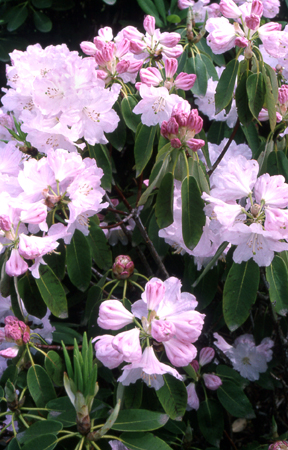
Rhododendron vernicosum is a member of the popular and widely grown group of related species known as subsection Fortunea (Fortunei Series). This subsection includes such familiar species as sutchuenense, calophytum, orbiculare, decorum, fortunei, oreodoxa, and griffithianum. Although less well known and not as common in gardens as these other deservedly popular species, R. vernicosum can be equally as magnificent and deserves greater recognition as a hardy, easily grown, and beautiful species.
In its native China this species is known as liang ye dujuan, the “glossy-leaved rhododendron.” This and the specific epithet vernicosum, meaning “varnished,” refer to the presence of a shiny and sticky substance on the upper surface of the foliage when heated or rubbed. This is due to the presence of a wax-like coating which normally gives a somewhat flat or dull green appearance to the foliage.
Rhododendron vernicosum was first documented by Europeans in 1893 when it was found by the Abbe Soulie at Tongolo in western Sichuan Province, China. It was introduced to the western world by E. H. Wilson in 1904 from seed collected by him in western Sichuan (W#1777). A fairly widespread, variable and common species throughout its native range, R. vernicosum was subsequently introduced by many collectors from many locations. It is found over a wide range of SW China but is centered in the Provinces of Sichuan and Yunnan, with scattered populations in Gansu and SE Xizang (Tibet). This species, in its many forms, occurs in a wide variety of montane habitats from 9,000 to 14,000 feet.
This species typically forms a large broadly upright or rounded shrub in cultivation, but is often found as a small tree up to 25 feet high in its native mountains. The evergreen foliage is extremely variable but typically somewhat elliptic to ovate-elliptic or oblong-oval. The leaves are glabrous (smooth) to the naked eye, but there are minute hairs on the pale green undersurface. The foliage can be quite similar to that of R. oreodoxa and especially R. decorum. In fact, it can be very difficult to distinguish this species from the latter without a close look, especially when the plant in question is not in flower. We were faced with this predicament many times while on a Rhododendron-hunting expedition to SW China in the fall of 1995 and again in the spring of 2006. In the field, it is most easily and reliably distinguished from similar forms of oreodoxa by its glandular style and from decorum by its lack of a scent and more or less reddish glands on the ovary and style; they are white in decorum.
The flowers are borne in a compact inflorescence containing six to twelve individual flowers. These are broadly funnel-campanulate (a wide-mouthed, funnel-shaped bell) and up to two inches in length with six or seven lobes. The color ranges from pale pink to rose or pinkish purple and rarely white, often with crimson flecks. There are 14 glabrous (smooth) stamens, but the ovary and style are densely covered with dark red glands. As with the foliage, the flowers of this species can be very similar to those of R. decorum but can be distinguished from it by, in addition to the characters mentioned earlier, its smooth stamens. The stamens of decorum are hairy at their bases. In the spring of 2006, we observed this species in many different regions of western Sichuan where it is often the dominant species from around 10,000 to 11,000 feet. I came away with a deeper appreciation for the beauty of this species, its large flaring bell-shaped flowers often in shades of a deep, rich pink. The sheer abundance of color splashed across the mountainsides represented by this single species was awe inspiring.
The incredible variation in appearance of R. vernicosum over its wide geographical range led to the designation of many forms as distinct species when they were first cataloged in the early part of this 20th century. After further study of herbarium specimens and additional observations of wild populations it became obvious that these “species” were just natural variations within a variable population. These were lumped into a broadly defined vernicosum and are now listed as synonyms. Many of these have since been treated as geographical “forms” of R. vernicosum, e.g., forma araliiforme, f. euanthum, f. rhantum, and f. sheltonae, but again, they are nothing more than accepted variations within an extremely variable population. One small and fairly uniform population observed in NE Yunnan during our fall 1995 expedition had foliage which reminded me of a somewhat elongated version of a R. orbiculare leaf. These scattered specimens had us all perplexed until we decided they represented an outlying population of the obviously even more extremely variable vernicosum than what we had learned to expect. A few years later, the first seedlings flowered – they were straight decorum!
In cultivation this species is relatively hardy with material collected from higher elevations and latitudes probably hardy to around -15°F. Other forms will not be as hardy, but most are satisfactory in the primary “rhododendron-growing” areas of the western and eastern coasts of North America, much of continental Europe, and all of Great Britain. In some areas the new growth can be damaged by early spring frosts due to its precociousness. It also seems to require better than average drainage as it is quite susceptible to Phytophthora root rot. As with most other members of its subsection, this species performs best in lightly shaded conditions. On the whole, R. vernicosum is a free-flowering, long-lived, and easily grown species which, in its finest forms, rivals almost any other in the beauty of its blossoms.
This species has rarely been used in hybridizing but several clones have been chosen for awards. These include an Award of Merit in 1964 to the clone ‘Loch Eck’ with pure white flowers from the Younger Botanic Garden, Benmore. The A.M. was given again in 1976 to the clone ‘Spring Sonnet’ with white flushed red-purple flowers grown from Rock#11408 and exhibited by Lord Aberconway, Bodnant. In 1969 the clone ‘Sidlaw’ from Glendoick was given a P.C. (Certificate of Preliminary Commendation).
(updated from the original publication in the January 1997 Newsletter)
ACCESSIONS IN THE COLLECTION OF THE RSF:
1969/812 Lancaster:Walker.
1970/353 Corsock.
1975/086 Exbury. Flowers white flushed rose with magenta flecks.
1975/127 ‘Loch Eck’ RBG Edinburgh. Flowers pure white.
1975/328 (“forma rhantum”) Reuthe:Berg. Flowers vibrant magenta (55A) with maroon flecks.
1976/177 RBG Edinburgh. Flowers white flushed pale rose.
1979/152 H.Sm.#13976:Goteborg Botanic Garden. Pink buds open to white flushed pink flowers.
2002/044 ‘Sidlaw’ Glendoick
NOTE: We have many newer accessions grown from wild-collected seed. These have yet to be evaluated.
REFERENCES CONSULTED:
Chamberlain, D. F. 1982. “A Revision of Rhododendron. II. Subgenus Hymenanthes.” Notes from the Royal Botanic Garden Edinburgh. Vol. 39(2): pgs. 230-231.
Cox, P. A. and K. N. E. Cox. 1997. The Encyclopedia of Rhododendron Species. Perth, Scotland: Glendoick Press.
Cox, Peter A. 1993. The Cultivation of Rhododendrons. London: B.T. Batsford Ltd.
Davidian, H. H. 1989. The Rhododendron Species. Vol. II. Portland, OR: Timber Press. Pgs. 201-203.
Hootman, S.E. Unpublished field notes: 1995-2006
Rhododendron Species Foundation: Records – 1964 to present.
